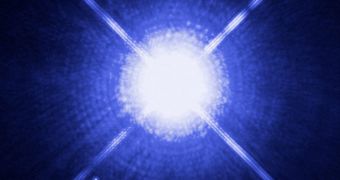Our solar system is about 4.6 billion years old, counting from the time the Sun fully developed onwards. Still, someday, things will change, and the Sun will eventually reach the end of its burning cycle. Researchers now explain what will happen next.
Our parent star is a massive ball of fire that is powered by nuclear fusion. The process takes place as hydrogen atoms meet up and are pressed into each other until they turn into helium.
As this happens, enormous amounts of energy are released, as light and other forms of radiation. This energy warms the Earth, and creates the heliosphere, the protective layer shielding the solar system from the harmful effects of cosmic rays in the interstellar medium.
But the Sun will not always be there for us, simply because it does not have sufficient hydrogen reserves to burn indefinitely. It will quietly fizzle out as all hydrogen is exhausted.
The process will take place gradually over the next 5 billion years or so, when the star will start to get gradually warmer. Then, some 10 billion years after it appeared, the Sun will turn into a red giant.
This means that it will swell until it nearly reaches the orbit of Mars. The other three inner planets, Mercury, Venus and Earth will be completely engulfed in the star, and disintegrated.
After this expansion stage reaches its peak, the outer layers of the solar atmosphere will gradually be shed to form a planetary nebula, and the star itself will collapse into a white dwarf, which is a helium-powered star.
Counting since its birth, it will take the Sun some 12 billion years to turn into a white dwarf, and it will then continue to burn on, but a lot dimmer and without emitting much heat, like 95 percent of all other stars in the Universe that don't end up in supernova explosions.
So, the Sun is a white dwarf, and three of the four inner planets are gone. The question is how the solar system will look then. The answer is very simple – nothing like it does today.
Firstly, as the red giant develops and life here is destroyed, the habitable zone of the star will move away into the solar system, which means that moons such as Titan, Enceladus or Europa might become tropical retreats.
However, when the Sun collapses, and the planetary nebula develops, the orbits of planets starting from Mars onwards will suffer modification. The current configuration of the system is only kept in place by the gravitational pull of the Sun.
As the star loses mass, its pull will invariably weaken, causing the orbits of Mars and the four gas giants to alter as well, Universe Today reports.
Mars and Jupiter, as the new innermost planets, will experience more drag as they move in orbit, since they will be passing through the newly-formed planetary nebula.
The orbits of Saturn, Uranus and Neptune will be unaffected by drag, but less gravitational pull will make them expand slowly. Their trajectories will not change in similar ways, as other factors are at work in determining new orbits in each individual case.
Astronomers say that there is a distinct possibility of some planets crashing into each other as their orbits become chaotic, resulting in a solar system that would look pretty much as it did when it first formed.

 14 DAY TRIAL //
14 DAY TRIAL //